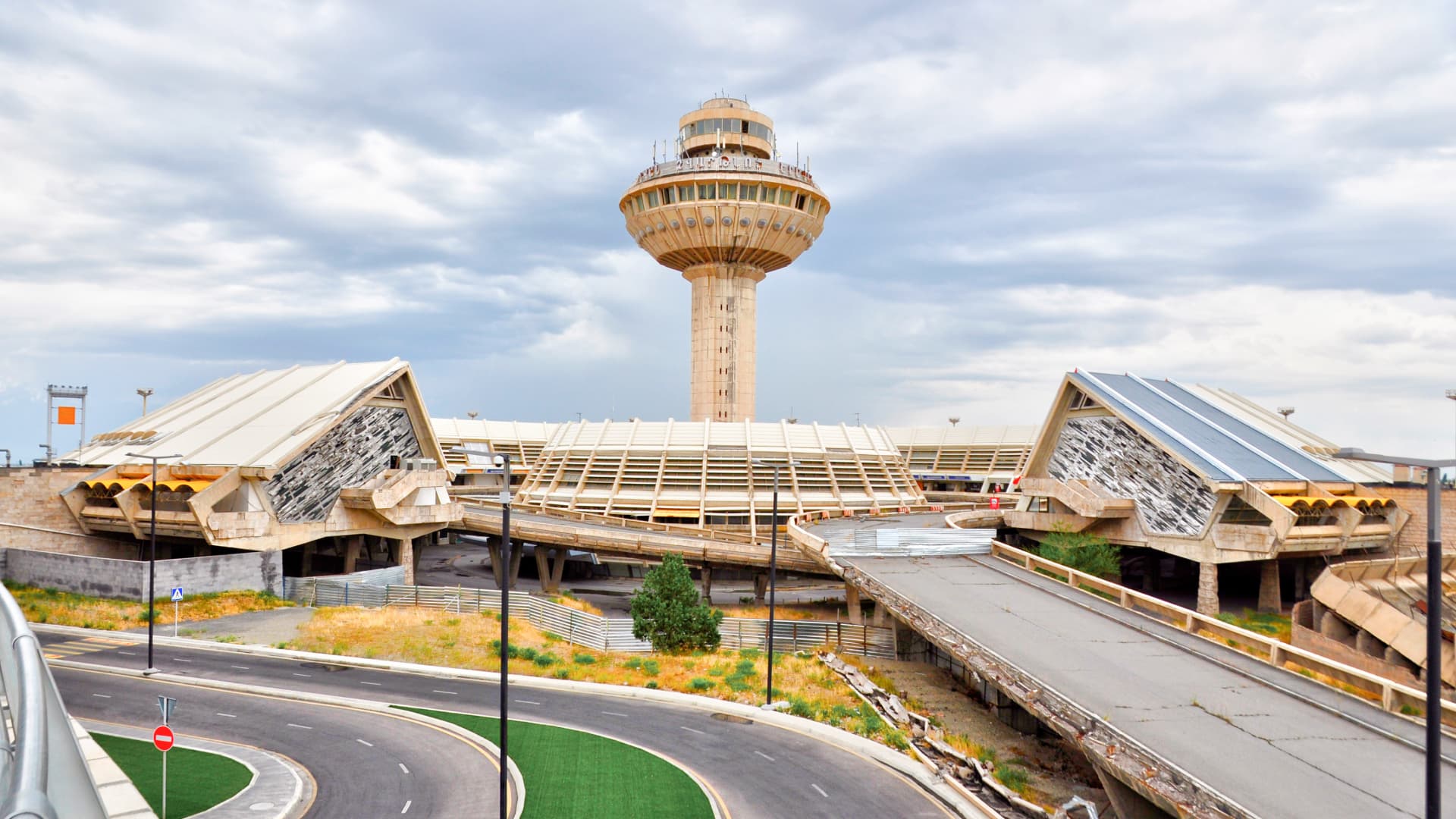How do you understand that the building in front of you is a monument of architecture of Modernism era? What is it all about, and why does modernist architecture leave no one indifferent: people adore it or hate it? What do the films of George Lucas and the old building of Zvartnots airport have in common? We touched upon these issues and much more with Anna Bronovitskaya, a historian of architecture and art critic, who is currently working on a guide-book on the modernist architecture of Yerevan and its environs.
Watch the full video of the interview with the incredible shots of amazing sites from a bird's eye view on our YouTube channeland don't forget to subscribe; a lot of interesting stuff still to come!
You will also find top recommendations on famous as well as on little-known amazing modernist era buildings in this video. Watch, save and share it with your friends. We recommend you take a walk and explore each of these amazing buildings yourselves.
S: French gardener Joseph Monnier grew tulips and constantly faced the problem of them falling. He tried to make clay fences to support them, but they were loose, wooden ones didn't last long. Monier came up with the idea of making a grid of iron and poured cement over it. Can we call him the forefather of Modernism?

A: I would argue with the idea of Modernism being reduced to iron and concrete, nonetheless, this gardener always appears in our stories about where modern architecture came from.
S: How long have you been in Armenia?
A: I have been here for the second time; I have spent almost a month here. I spent a month in Yerevan last autumn as well.
S: You are currently writing a book on Yerevan modernist architecture, which continuesthe series of Garage Museum of Contemporary Art program on Moscow, Leningrad and Alma-Ata Modernism. Are there any peculiarities in working on this particular book, perhaps in the process of information collection?

A: This is a part of a bigger project. We want to cover different regions of the former Soviet Union, if possible, because these books are guides, they are intended for a wide audience. At the same time, we want to make them at an academic level: so that all the information is checked, so that there are plans, correct names, correct dates, links to sources of information, and so on.
The specificity unlike, say, Kazakhstan or Uzbekistan (where my colleagues are also working on a book from this series) is that Armenia was much less russified. There were newspapers in Russian, but this was the "Kommunist" newspaper, for instance, or the "Komsomolets". There were no special architectural editions, no newspaper, which usually help us a lot. Say, it would be cool to look through “Evening Yerevan”: it would help a lot to understand the context. We always look not only for some professional materials, but also for people's responses to, for instance, the information that the city needs a Youth Palace or a large cinema, or something else. We have some difficulty with this.
Therefore, meetings with people, conversations with architects are of great importance. Some architects who worked in the 70-80s, I am happy to say it, are still alive, and you can talk to them. Besides, we can talk to either young colleagues or just people from the field of architecture as well. We talk to descendants a lot, because Armenia is a rather patriarchal country: parents and grandparents are respected here and their archives are often saved. Therefore, we rely on human contacts.
S: You are an architecture critic. What does it mean in simple terms?
In fact, I am an architectur critic least of all, I'm more a historian. I have education of an art historian, but I am mainly engaged in the history of architecture of the 20th century. I worked for architectural magazine "Project Russia"for ten years; it is still being published. It is the main architectural magazine in Russia devoted to modern architecture, but I wrote historical materials on the architecture of Soviet Modernism for them. I was also responsible for Project Intarnetional , a digest of the world contemporary architecture and design. Our task was to choose some interesting topics and explain them more deeply than Internet resources do. This helps me to understand some context of modern architectural issues
S: How do you define modernist architecture?
A: It is the architecture which is the most modern when the buildings of that style are built. If we are talking about the period which our book is dedicated to, Soviet Modernism, in general, this is late Soviet architecture. In the 1920s we had the avant-garde. There was, what we call — very inaccurately — "Stalinist" architecture: it is about historicizing, using columns, plasterwork and some old prototypes. At the beginning of 1960 there was a return to modern architecture, to industrial methods of construction.
Concrete, metal, glass, the modern forms—this is what we are engaged in.
S: Probably, while walking around Yerevan, Gyumri or Vanadzor, you come across the modernist architecture. Is there some distinguishing or characteristic feature to determine that this building definitely belongs to the era of Modernism?
A: Most of what surrounds us (so far) was built at that time. First of all, this is a typical housing in which most of us live or lived at some point. Very often these buildings are larger, they stand out in scale. For example, when you walk around Yerevan, and suddenly some towers appear there. There are more of them now, of course. But at that time it was believed that modernity was very good. The more modern the better. And when these high-rise buildings were being built, the first ones in such Yerevan of the Tumanyan era, where the buildings were those of 4-5 floors, and suddenly - 9-12-15 floors! The city seemed to become modern. Armenia was moving into the future together with the rest of the mankind.
But, again, Armenia has its own charachteristic features. If we were talking about Moscow, I would say: it's glass and concrete. Armenia has its own powerful traditions and many buildings even of this era are lined with tuff. They were often built from tuff because it is the cheapest building material, even cheaper than reinforced concrete. And if the building was not too high, it was built from tuf not just lined with it.
In addition, the architects had a craving for decoration. Real modernism does, as a rule, without ornaments. Armenian architects believed that there should be a relief, some references to the national tradition.
S: Isn't it considered excessive amount of decoration? What about functionality?
One of the most remarkable monuments of Мodernism in Yerevan, which is now in a terrible and neglected state, is the summer hall of cinema Moscow. It was built in the sixties, it is a picece of magnificent modernism, one might even say - of brutalism, because there is a lot of exposed concrete and sculptural form, some holes through which trees grew. And it's very cool! But, from the point of view of functionality, of course, it was not very convenient to watch a movie there, and, probably, it was not very convenient for the residents of the surrounding houses, when people watch movies there.

As for excessive decoration, there is such a problem, especially in case of the structures built in the 1980s. And there is an enchanting building — sports and concert complex after Karen Demirchyan with a very strong, unusual architectural form, innovative design, technologies, but it is a very decorated one. Anywhere else it would look strange. I read about the discussion held in the USSR Union of Architects when this complex was being nominated for the Lenin Prize. And there, too, many architects said 'Listen, what is this? There are so many all kinds of decorations, an excess of various decorative techniques. It is such eclecticism'. But then an architect from Estonia, who was inclined towards minimalism and pure form, took the word. And she said that, you know, these are, of course, some of their Armenian features, but it is an outstanding building, let's nominate it for the Lenin Prize. And this complex was awarded the main architectural prize in the USSR.

We will very soon publish the continuation of the conversation. For now, you can study Anna Bronovitskay's recommendations of the most famous and less obvious buildings of the modernist era in Yerevan and its environs..














Add a comment